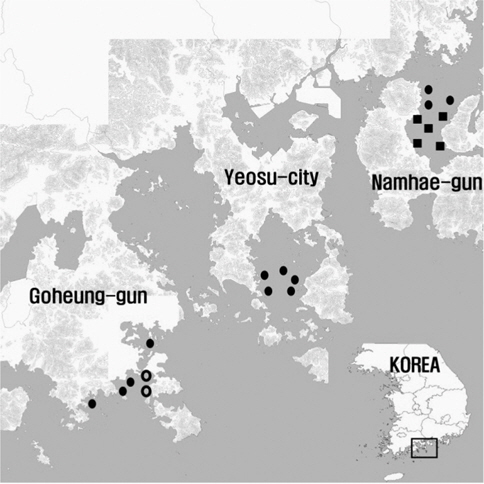



This study evaluated the impact of antimicrobial resistant bacteria produced by inland pollution sources on coastal areas, and investigates antimicrobial resistance profiles of bacteria isolated from marine filter feeders. A total of 107 shellfish (short-necked clams
항균제는 사람이나 동물의 질병을 예방하거나 치료하기 위하여 광범위하게 사용 되어지고 있으며 2012년 농림수산검역 검사본부의 축산용 항균제 사용량 조사 자료에 의하면 우리나라의 동물용 항균제 사용량은 2008년 1,210톤, 2009년 998톤, 2010년 1,046톤, 2011년 956톤으로 조금씩 줄어드는 추세이나 수산용 항균제 사용량은 2008년 193톤, 2009년 178톤, 2010년 203톤, 2011년 239톤으로 오히려 항균제 사용량이 증가하고 있는 것으로 나타났다.
이처럼 항균제는 양식 어류에서의 질병 예방이나 치료를 목적으로 널리 사용되고 있을 뿐만 아니라 이들 항균제 중 일부는 동물의 생산성을 증가시키기 위한 성장 촉진제로 사료와 혼합하여 사용되기도 한다(Tollefson et al., 1997; Gaskins et al., 2002). 그러나 이러한 목적으로 사용되는 항균제는 오·남용으로 인하여 수산분야에 있어서 항균제 내성균 출현뿐만 아니라 다제내성균의 증가 문제를 야기 시킬 수 있다. 특히 항균제를 투여한 축산 동물이나 사람의 분변으로부터 약제내성균이 자연환경으로 방출되기도 하며, 사람이나 동물에게 투여한 항균제가 완전히 소화 흡수되지 않고 섭취된 항균제의 경우 약 70%정도가 성분이 변하지 않은 상태로 배설된다는 보고도 있다 (Kummerer, 2009).
한편, 패류는 연안해역에 주로 서식하며 육상과 인접해 있어 배수유역에서 유입되는 오염물질의 영향을 쉽게 받을 수 있으며, 또한 이동성이 거의 없고, 여과섭이 활동을 통하여 먹이를 섭취하는 패류는 해수 중에 부유하는 세균들을 체내에 쉽게 축적하게 된다(Grimes, 1991; Feldhusen, 2000).
최근 인구의 증가와 산업발전으로 인하여 일부 생활폐수, 산업폐수 그리고 사람이나 가축으로부터 배설된 분변 등의 오염원이 하수구나 하천을 통하여 해상으로 유입됨으로써 연안 해역의 수질에 악 영향을 미치고 있으며(Hill et al., 2006; Lee et al., 2010), 이러한 오염원에는 항균제 내성균이 함유되어 있을 가능성이 높아 패류의 위생학적 안전성을 위협하는 요인이 될 수 있다.
한편, 대장균은 사람이나 동물의 장내에 상재하는 정상 세균총으로 빈번하게 투여되는 항균제에 노출되어 있기 때문에 항균제에 의한 내성 획득 과정을 이해하고, 내성균을 모니터링 함에 있어 매우 유용한 세균으로 알려져 있다(Levin et al., 1997). 국내에서도 대장균의 항균제 내성에 관한 모니터링 및 연구가 많이 이루어지고 있는데, 주로 가축으로부터 분리한 대장균에 관한 연구이다(Chae et al., 2005; Lee et al., 2005; Cho et al., 2006; Kim et al., 2009).
수산분야에 있어서도 어류양식장에서 분리한 대장균, 장구균 및 비브리오균에 관한 항균제 내성균 연구는 일부 이루어져 있으나(Son et al., 2005; Oh et al., 2008; Son et al., 2009), 육상오염원과 인접해 있어 배수유역에서 유입되는 오염물질의 영향을 많이 받고 있는 패류양식장에서의 분리한 대장균의 항균제 내성에 관한 연구가 미미한 실정이다.
한편, 전남 고흥군 나로도 및 여수시 가막만, 경남 남해군 강진만 해역의 패류양식장에서 양식 중인 굴, 바지락 및 피조개는 강우 발생 후 이들 해역의 배수유역으로부터 유입되는 오염물질의 영향으로 인해 패류 중의 분변계대장균의 오염도가 크게 증가한다는 보고가 있고, 이들 해역의 배수유역에서 발생하고 있는 사람 및 가축의 분변이 적절하게 위생 처리되지 않고 패류생산해역으로 유입되고 있는 실정임으로 오염물질 중에 함유되어 있는 항균제 내성균들이 패류에서 분리되는 대장균의 항균제 내성에 영향을 미칠 수 있을 것으로 사료된다(Kwon et al., 2007; Park et al., 2011; Park et al., 2012).
따라서 본 연구에서는 항균제 내성균 및 육상오염원 관리를 위한 기초자료 제공하고자 고흥군 나로도, 여수시 가막만 및 남해군 강진만 해역내의 패류양식장에서 양식 중인 패류로부터 대장균을 분리하고, 분리된 대장균에 대한 항균제 내성 패턴을 조사하였다.
대장균 분리를 위한 시료는 2011년 10월부터 2012년 5월까지 전남 고흥군 나로도 및 여수시 가막만, 경남 남해군 강진만 해역의 패류양식장에서 양식 중인 굴(
대장균시험은 Recommended Procedures for the Examination of Sea Water and Shellfish (A.P.H.A., 1970)에 준하여 시험하였다. 추정시험에는 Lauryl Tryptose broth (Difco, USA)를, 확정시험에는 EC broth (Merck, Germany)를 사용하였다. EC broth의 양성 시험관으로부터 균을 분리하여 EMB agar (Difco, USA)에 도달한 후 금속성 광택 집락의 의심균주는 IMViC test 및 VITEK system (BioMerieux Vitek, France)를 이용하여
분리·동정된 각 대장균의 항균제 감수성은 Acar and Goldstein (1991)의 디스크 확산법 과 미국 CLSI (Clinical and Laboratory Standards Institute, 2004)에 준하여 시험하였다. 즉, 분리된 각 균주는 Muller Hinton Broth (Merck, Germany)에서 35℃, 18~24시간 배양한 다음 균주 배양액의 농도를 McFarland No. 0.5로 희석 조정하였다. 각 희석된 균액은 미리 1% 농도가 되도록 NaCl를 첨가한 두께 4 mm의 Muller Hinton Agar (Merck, Germany) 평판에 도말하였다. 균액이 접종된 Muller Hinton Agar 평판은 5분간 방치하여 균액을 흡수시킨 후 항균제 디스크(Φ 8 mm)를 평판에 고착시켰다. 이 때 항균제 디스크는 균 접종 후 15분 이내에 고착시켰으며, 시험 항균제는 ampicillin (10 μg; AM), amoxicillin/clavulanic acid (20 μg/ μg; AmC), aztreonam (30 μg; ATM), cefazolin (30 μg; CZ), cefotaxime (30 μg; CTX), ceftazidime (30 μg;CAZ), cephalothin (30 μg; CF), chloramphenicol (30 μg; C), gentamicin (10 μg; GM), nalidixic acid (30 μg; NA), streptomycin (10 μg; S), rifampin (5 μg; RA), tetracycline (30 μg; TE), trimethoprim/ sulfamethoxazole (1.25 μg/23.75 μg; SXT), trimethoprim (5 μg; TMP) 등 15종으로 BBL사 제품을 사용하였다. 항균제 디 스크를 고착시킨 Muller Hinton Agar 평판은 35℃, 16-18시간 배양한 다음 균의 증식 저해대(inhibition zone)의 크기를 calipers로 측정하여 감수성 유무를 판별하였으며, 감수성 결과의 정도 관리를 위하여
>
Escherichia coli의 분리 및 항균제 내성율
2011년 10월부터 2012년 5월까지 남해안 3개 지역(고흥, 여수, 남해)에 소재하는 패류양식장 19개소에서 직접 채취한 굴 71점, 바지락 15 점, 피조개 21 점 등 총 107 점 대상으로
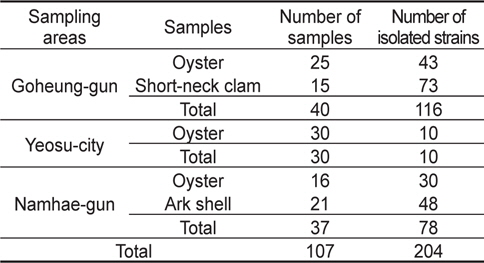
Number of Escherichia coli isolated from oyster Crassostrea gigas, short-neck clam Ruditapes philippinarum and ark shell Scapharca broughtonii
한편, 분리된
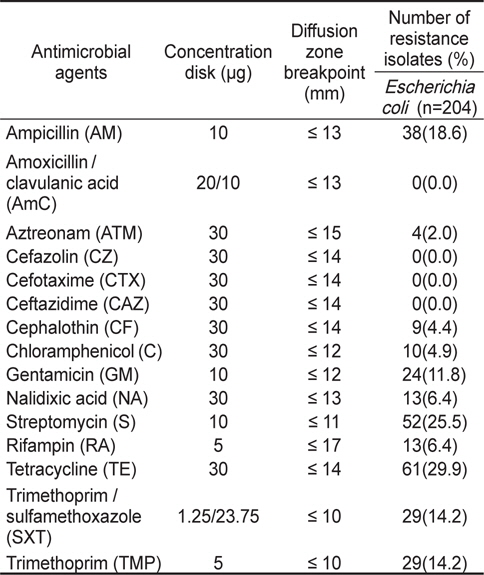
Antimicrobial resistance of Escherichia coli isolated from oyster Crassostrea gigas, short-neck clam Ruditapes philippinarum and ark shell Scapharca broughtonii
Lee et al. (2003)가 보고한 각종 수산물로부터 분리한
시험균주의 분리지역에 따른 항균제 내성 경향을 Table 3에 나타내었다. 고흥 나로도 해역에서 분리된 대장균은 tetracycline와 streptomycin에 대한 내성율이 각각 38.8% 및 30.2%로 나타내었고 amoxicillin/clavulanic acid, cefazolin, cefotaxime, ceftazidime에서는 감수성을 보였으나, 남해 강진만 해역에서 분리된 대장균은 ampicillin, gentamicin, trimethoprim/sulfamethoxazole, trimethoprim에 대한 내성율이 공히 24.4%로 확인되었고, tetracycline와 streptomycin에 대한 내성율이 각각 20.5% 및 10.3%로 나타났고, amoxicillin/clavulanic acid, cefazolin, cefotaxime, ceftazidime, cephalothin, chloramphenicol, nalidixic acid에서는 감수성을 보여 나로도 해역에서 분리된 대장균의 항균제 내성 경향하고는 다소 차이가 있는 것으로 조사되었다. 또한 고흥 나로도 해역의 패류양식장에서 분리된 대장균이 여수 가막만 및 남해 강진만 해역에서 분리된 대장균들보다는 많은 항균제에 내성을 보이는 것으로 확인되었다.
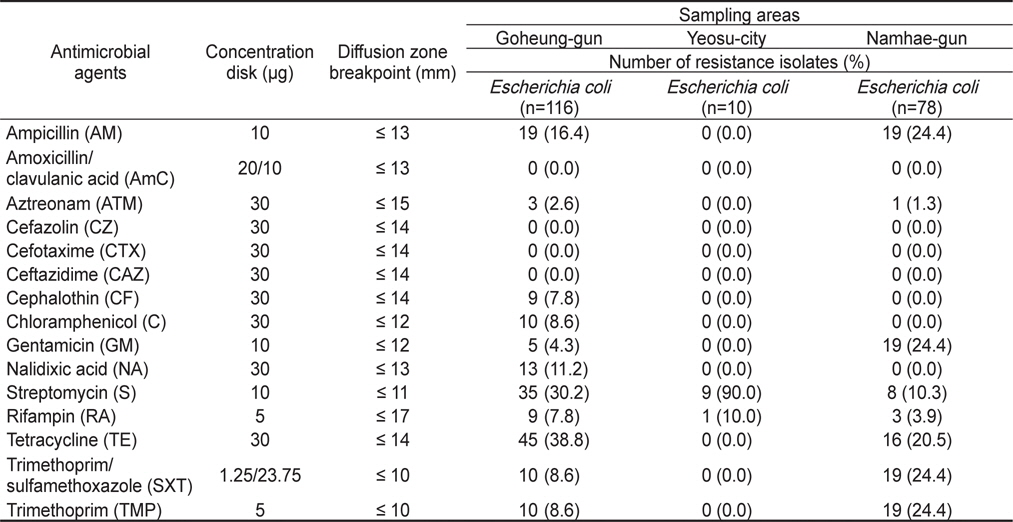
Distribution of antimicrobial resistance in the sampling area of Escherichia coli isolated
Lee et al. (2005)은 닭 분변 유래의 대장균에서 tetracycline (95.2%), ampicillin (70.1%), streptomycin (59.2%), trimethoprim/ sulfamethoxazole (53.7%) 내성율이 높았고, Choi et al. (2006)은 양돈 분변에서 분리한 대장균에서 tetracycline (100%), trimethoprim/sulfamethoxazole (60.2%), ampicillin (50.0%), streptomycin (50.0%) 내성율이 50%이상이었다고 보고하였다.
한편, 나로도 및 강진만 해역에 양식 중인 굴과 피조개의 위생학적 성상은 강우 발생 후 이들 해역의 배수유역에서 유입되는 분변성 오염물질의 영향으로 인해 분변계대장균의 오염도가 크게 증가되었다고 보고하였으며(Park et al., 2011; Park et al., 2012), Herwing et al. (1997)은 어류양식장에서 항균제를 사용함으로써 해양환경에 존재하는 세균의 내성 정도를 증가 시킬수 있으며, 항균제를 많이 사용한 어류양식장의 침전물로부터 분리된 세균의 내성율은 항균제를 거의 사 용하지 않은 어류양식장의 침전물로부터 분리한 세균의 내성율에 비하여 매우 높았다고 하였다.
이상의 결과를 종합해보면, 나로도 및 강진만 해역에서 분리된 대장균의 항균제 내성 차이는 이들 해역의 배수유역에 소재하고 있는 사람이나 가축에 사용하는 항균제 사용량 차이, 해역으로 유입되는 분변성 오염물질의 종류 및 육상오염원 중에 함유되어 있는 대장균의 항균제 내성 차이 등의 요인으로 인해 지역별로 항균제 내성 차이가 나타난 것으로 사료된다. 따라서 패류에서 항균제 내성균 및 다제내성균 검출은 육상오염원의 영향이 가장 큰 요인으로 생각되기 때문에 패류의 위생학적 안전성 확보와 항생제 내성균 감소를 위해서는 패류 생산해역으로 유입되는 분변성 오염물질 차단을 위한 육상오염원의 관리 대책이 필요하다.
패류에서 분리된
[Table 4.] The antimicrobial resistance profiles of Escherichia coli isolated from samples
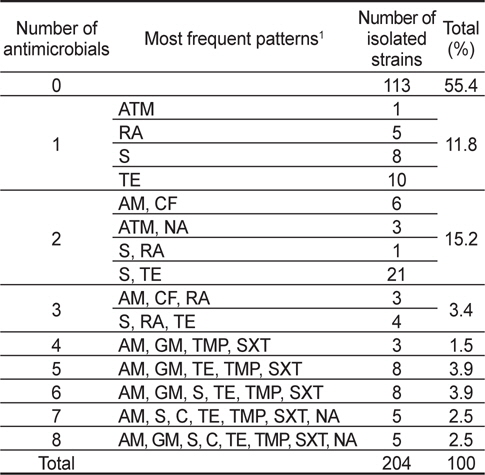
The antimicrobial resistance profiles of Escherichia coli isolated from samples
Lee et al. (2003)가 보고한 각종 수산물로부터 분리된
이상의 결과 육상오염원의 영향을 쉽게 받는 연안해역에서 서식하는 패류는 해역으로 유입되는 오염물질 속에 함유되어 있는 항균제 내성균 및 다제내성균 유입과 항균제 사용량이 증가하고 있는 육·해상 어류양식장으로부터 배출되는 항균제의 노출 영향으로 인해 패류뿐만 아니라 다른 수산물에서도 다제내성균 검출율이 증가할 가능성이 높아지고 있다. 따라서 항균제 내성균 및 다제내성균 증가를 억제하기 위해서는 축산이나 수산분야에서 질병 예방, 치료 및 성장 촉진을 목적으로 사용되는 항균제의 적절한 관리대책, 가축사육이나 어류사육 종사자들에 대한 올바른 항균제 사용 지침에 관한 지속적인 교육이 필요하다고 사료된다.
